1998 VOLVO V90 wheel
[x] Cancel search: wheelPage 30 of 175
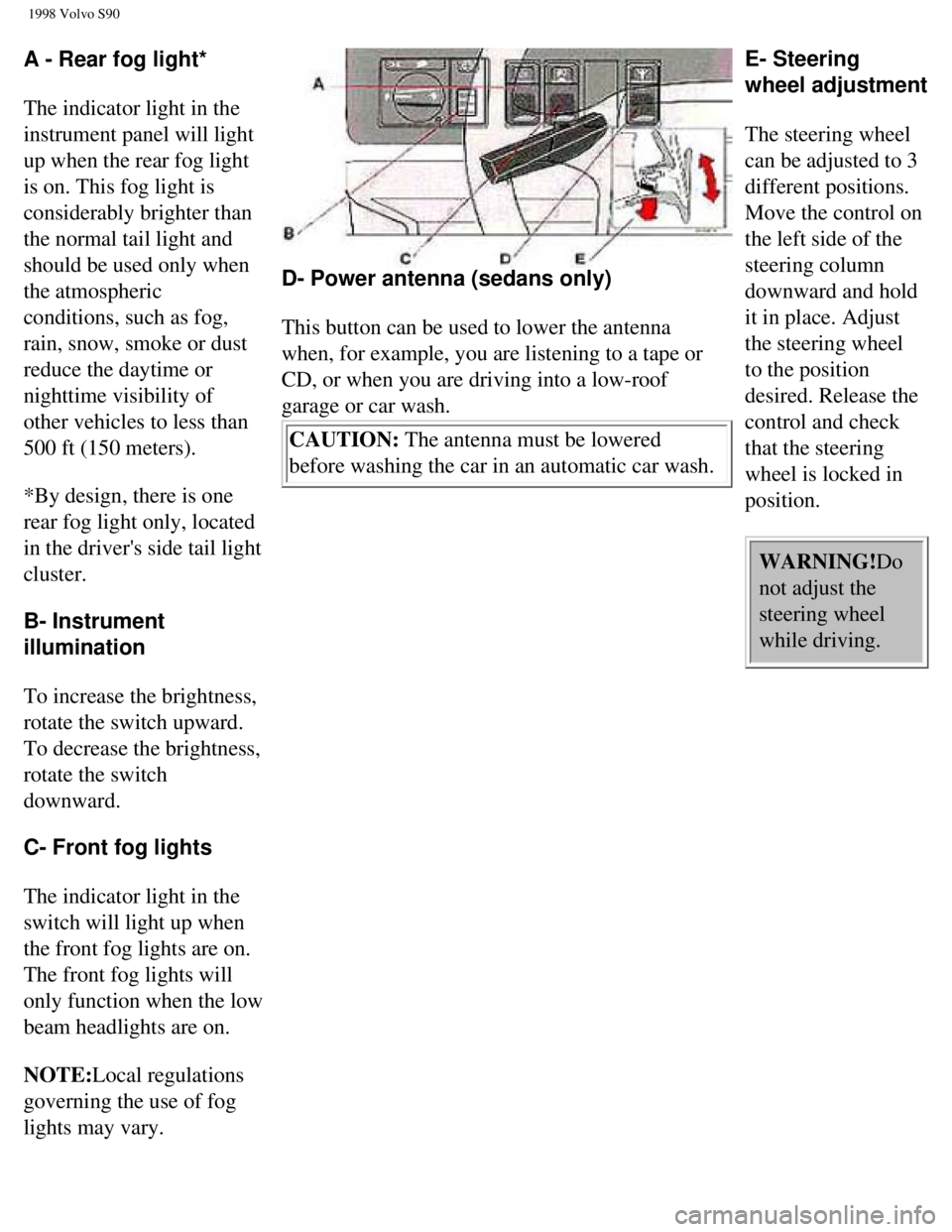
1998 Volvo S90
A - Rear fog light*
The indicator light in the
instrument panel will light
up when the rear fog light
is on. This fog light is
considerably brighter than
the normal tail light and
should be used only when
the atmospheric
conditions, such as fog,
rain, snow, smoke or dust
reduce the daytime or
nighttime visibility of
other vehicles to less than
500 ft (150 meters).
*By design, there is one
rear fog light only, located
in the driver's side tail light
cluster.
B- Instrument
illumination
To increase the brightness,
rotate the switch upward.
To decrease the brightness,
rotate the switch
downward.
C- Front fog lights
The indicator light in the
switch will light up when
the front fog lights are on.
The front fog lights will
only function when the low
beam headlights are on.
NOTE:Local regulations
governing the use of fog
lights may vary.
D- Power antenna (sedans only)
This button can be used to lower the antenna
when, for example, you are listening to a tape or
CD, or when you are driving into a low-roof
garage or car wash. CAUTION: The antenna must be lowered
before washing the car in an automatic car wash. E- Steering
wheel adjustment
The steering wheel
can be adjusted to 3
different positions.
Move the control on
the left side of the
steering column
downward and hold
it in place. Adjust
the steering wheel
to the position
desired. Release the
control and check
that the steering
wheel is locked in
position.
WARNING!Do
not adjust the
steering wheel
while driving.
file:///K|/ownersdocs/1998/1998_SV90/98S90_017.htm (6 of 7)12/30/2006 \
1:52:36 PM
Page 34 of 175
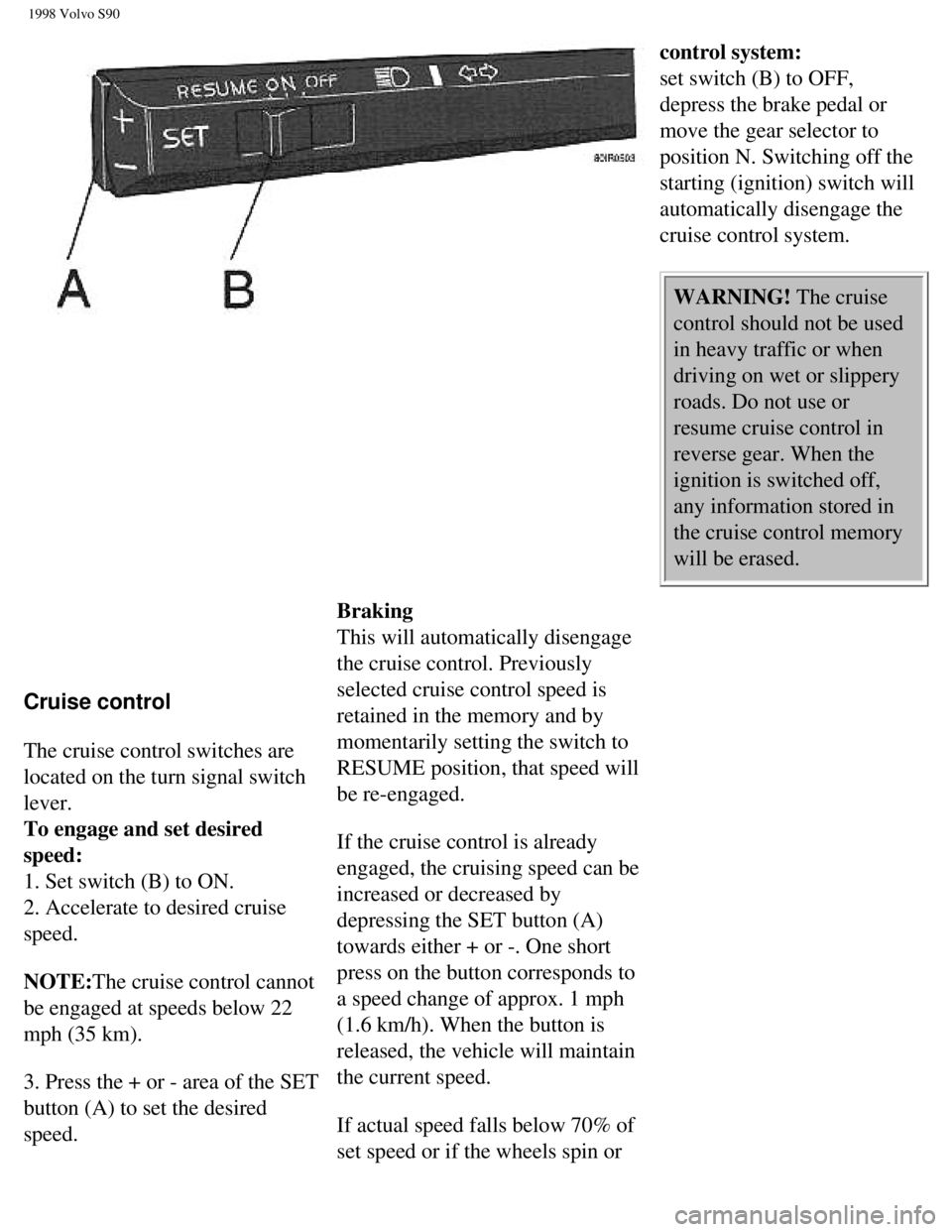
1998 Volvo S90
control system:
set switch (B) to OFF,
depress the brake pedal or
move the gear selector to
position N. Switching off the
starting (ignition) switch will
automatically disengage the
cruise control system.
WARNING! The cruise
control should not be used
in heavy traffic or when
driving on wet or slippery
roads. Do not use or
resume cruise control in
reverse gear. When the
ignition is switched off,
any information stored in
the cruise control memory
will be erased.
Cruise control
The cruise control switches are
located on the turn signal switch
lever.
To engage and set desired
speed:
1. Set switch (B) to ON.
2. Accelerate to desired cruise
speed.
NOTE:The cruise control cannot
be engaged at speeds below 22
mph (35 km).
3. Press the + or - area of the SET
button (A) to set the desired
speed. Braking
This will automatically disengage
the cruise control. Previously
selected cruise control speed is
retained in the memory and by
momentarily setting the switch to
RESUME position, that speed will
be re-engaged.
If the cruise control is already
engaged, the cruising speed can be
increased or decreased by
depressing the SET button (A)
towards either + or -. One short
press on the button corresponds to
a speed change of approx. 1 mph
(1.6 km/h). When the button is
released, the vehicle will maintain
the current speed.
If actual speed falls below 70% of
set speed or if the wheels spin or
file:///K|/ownersdocs/1998/1998_SV90/98S90_023.htm (3 of 7)12/30/2006 \
1:52:37 PM
Page 40 of 175

1998 Volvo S90
the above illustration.
The starting (ignition) switches must be ON
(position II) for the electrically operated windows
to function. The window is lowered if the rear part
of the switch is pressed and raised if the front part
of the switch is pressed.
NOTE: Driver's window only (AUTO): The
window can be opened completely by pressing the
rear part of the switch lightly and releasing it
immediately. The window can be stopped by
pressing the button again. If the button is held
down, the window will be lowered until the button
is released.
WARNING!Remove the starting (ignition)
key when children are left unattended in the
vehicle.
Make sure that children's hands are clear
before raising the windows. is positioned 90° in relation to the other switches.
ON The rear door windows can be raised or
lowered with the respective door switch as well as
the switch on the driver's door.
OFF The rear door windows cannot be raised or
lowered with the respective door switch but
instead only with the corresponding switch on the
driver's door.
NOTE: The power window motors have an
overload protecting circuit breaker which is
activated when an object blocks a window.
Should this occur, remove the object and wait 20
seconds for the circuit breaker to reset. The power
windows should then function.
Parking brake, Cigarette lighter, Ashtrays pg. 30
Parking brake (hand brake)
The lever is situated between
the front seats. The brake is
applied to the rear wheels.
Cigarette lighter/ashtrays
To operate, depress the knob
fully. When the knob
automatically releases, the
cigarette lighter is ready for use.
The starting (ignition) switch
must be switched on (to position
I or II) for the cigarette lighter
to function.
"OBD II"
A connector for on-board
diagnostics ("OBD II") is located
to the right of the parking brake.
This connector is intended for
use by authorized service
technicians only.
file:///K|/ownersdocs/1998/1998_SV90/98S90_028.htm (2 of 3)12/30/2006 \
1:52:38 PM
Page 41 of 175
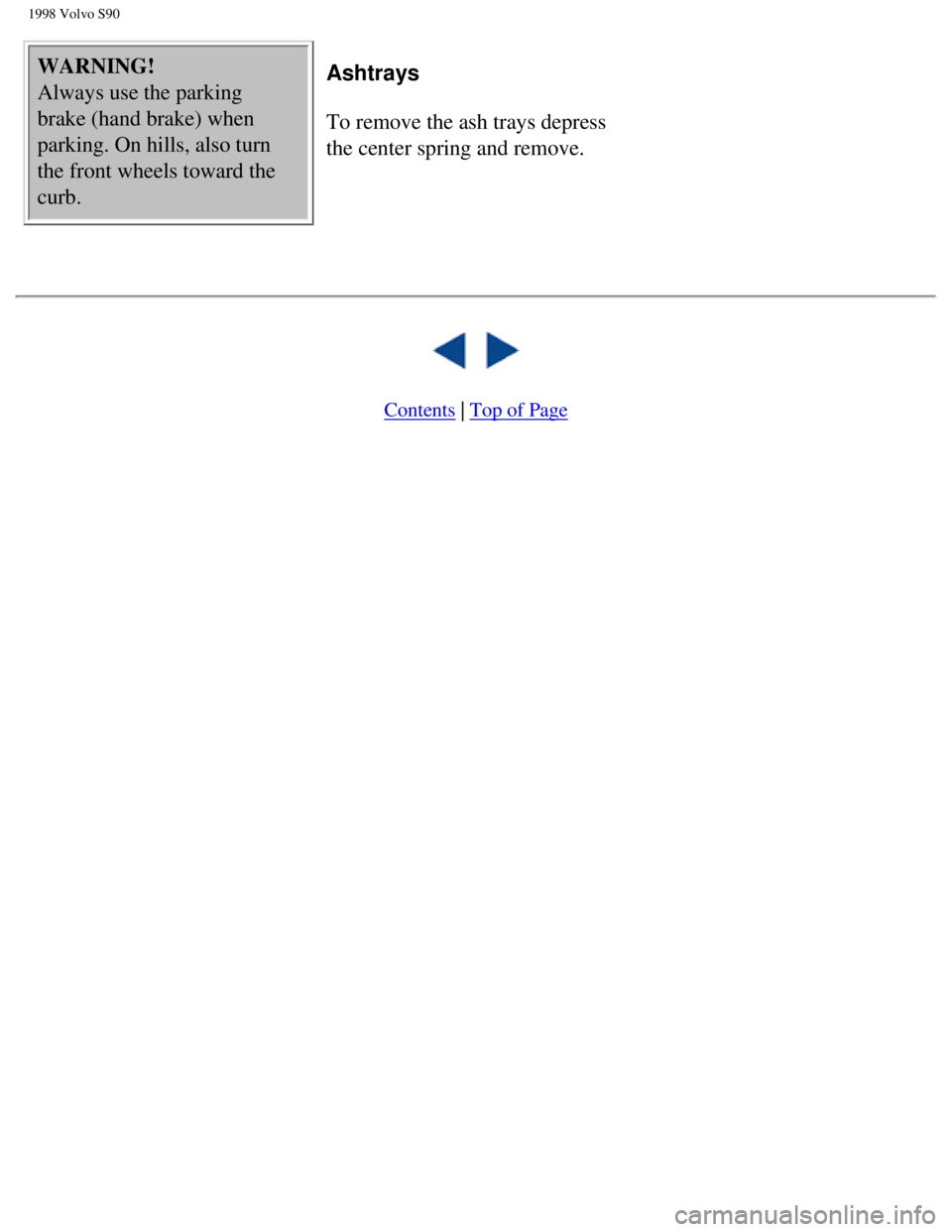
1998 Volvo S90
WARNING!
Always use the parking
brake (hand brake) when
parking. On hills, also turn
the front wheels toward the
curb.
Ashtrays
To remove the ash trays depress
the center spring and remove.
Contents | Top of Page
file:///K|/ownersdocs/1998/1998_SV90/98S90_028.htm (3 of 3)12/30/2006 \
1:52:38 PM
Page 43 of 175

1998 Volvo S90
Master key
This key operates all locks
Service key
Front doors, starting (ignition)
switch/steering wheel lock Number tag
The key number codes are
stamped on a separate tag supplied
with the keys. This tag should be
separated from the key ring and
kept in a safe place. In the event
the original keys are lost,
duplicates may be ordered from
your Volvo retailer.
Doors and locks
Your car is equipped with a central
locking system.
The key used on either of the front
doors will lock/unlock all doors and
trunk/tailgate.
Turn the key once in the driver's
door to unlock that door only.
Turn the key in the same direction
again (within 10 seconds) to unlock
all doors, trunk/tailgate.
One turn with the key towards
locking in either of the front doors
locks all doors, trunk/tailgate.
Use the switch on the instrument
panel (with the doors closed) to
lock/unlock the car from the inside.
Check the action of the buttons on
the other doors to verify their
correct function (lock/unlock). The
driver's door can be locked only by
using the key when outside the
vehicle.
On vehicles equipped with the
optional remote control locking
system, refer to the following
page.
WARNING!
The doors should not be locked
while driving. In case of an
accident, this may hinder rapid
access to the occupants of the
vehicle. (Also see information
on "child safety locks").
Remote keyless entry system pg. 33
file:///K|/ownersdocs/1998/1998_SV90/98S90_031.htm (2 of 6)12/30/2006 \
1:52:39 PM
Page 71 of 175

1998 Volvo S90
disconnected, the code must
be re-entered before the radio
will function properly.
Points to remember pg. 62
Weight distribution affects
handling
At the specified curb weight
your car has a tendency to
understeer, which means that the
steering wheel has to be turned
more than might seem
appropriate for the curvature of
a bend. This ensures good
stability and reduces the risk of
rear wheel skid. Remember that
these properties can alter with
the vehicle load. The heavier the
load in the trunk, the less the
tendency to understeer.
Handling, roadholding
Vehicle load, tire design, and
inflation pressure, all affect
vehicle handling. Therefore,
check that the tires are inflated
to the recommended pressure
according to the vehicle load.
See "Tire pressure" section.
Loads should be distributed so
that capacity weight or
maximum permissible axle loads
are not exceeded.
WARNING!
An extra mat on the driver's
floor can cause the
accelerator pedal to catch.
Check that the movement of
the accelerator pedal is not
impeded. Not more than one
protective floor covering may
be used at one time.
CAUTION: Drive slowly and
carefully if going through
standing water (i.e. flooded
roadways, etc.). Damage to
engine could result if excess
water is ingested through the air
intake system. Never drive the
vehicle in water deeper than 1
foot (300 mm). See the flood
warning on page 7.
WARNING! Do not drive
with trunk lid or tailgate
open!
Poisonous exhaust gases may
enter via the trunk lid or
tailgate.
If the trunk lid/tailgate must
be kept open for any reason,
proceed as follows:
l Close the windows.
l Set the ventilation system
Roof rails/racks
Roof rails are standard
equipment on wagon models.
Load bars are available as a
retailer installed option on the
sedan models. Observe the
following points when is use:
l Avoid single-point loads.
Distribute the load evenly.
l Place heavier cargo at bottom
of load.
l Observe that center of gravity
and handling are influenced by
load weight.
l Increasing load size increases
wind resistance and, thus,
adversely affects fuel economy.
l Anchor the cargo correctly
with appropriate tie-down
equipment.
l Drive carefully. Avoid rapid
starts, fast cornering and hard
braking.
l Max. roof load is 220 lbs.
(100 kg) for removable racks.
For permanent roof racks, check
the manufacturers weight
specifications.
file:///K|/ownersdocs/1998/1998_SV90/98S90_058.htm (6 of 7)12/30/2006 \
1:52:42 PM
Page 72 of 175
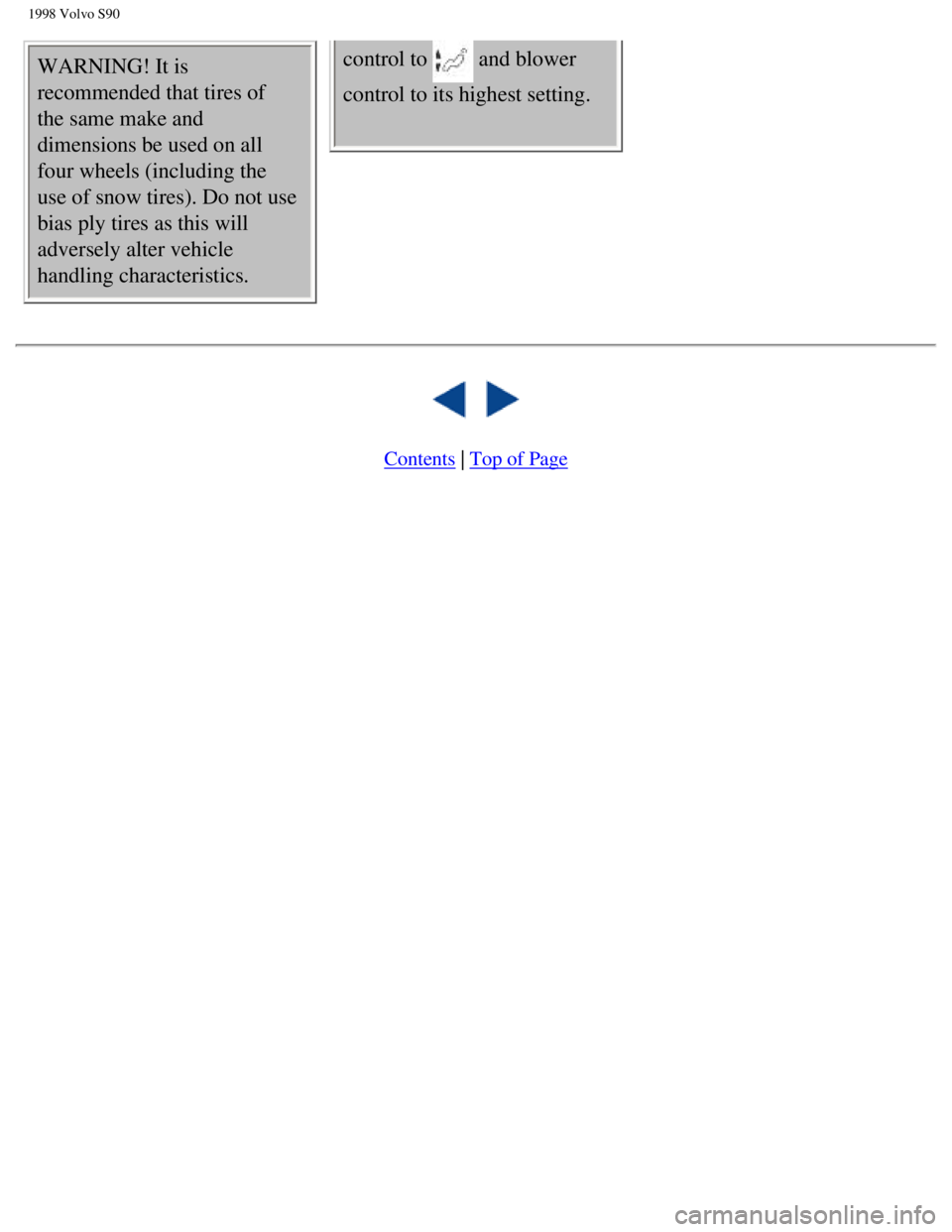
1998 Volvo S90
WARNING! It is
recommended that tires of
the same make and
dimensions be used on all
four wheels (including the
use of snow tires). Do not use
bias ply tires as this will
adversely alter vehicle
handling characteristics. control to and blower
control to its highest setting.
Contents | Top of Page
file:///K|/ownersdocs/1998/1998_SV90/98S90_058.htm (7 of 7)12/30/2006 \
1:52:42 PM
Page 73 of 175
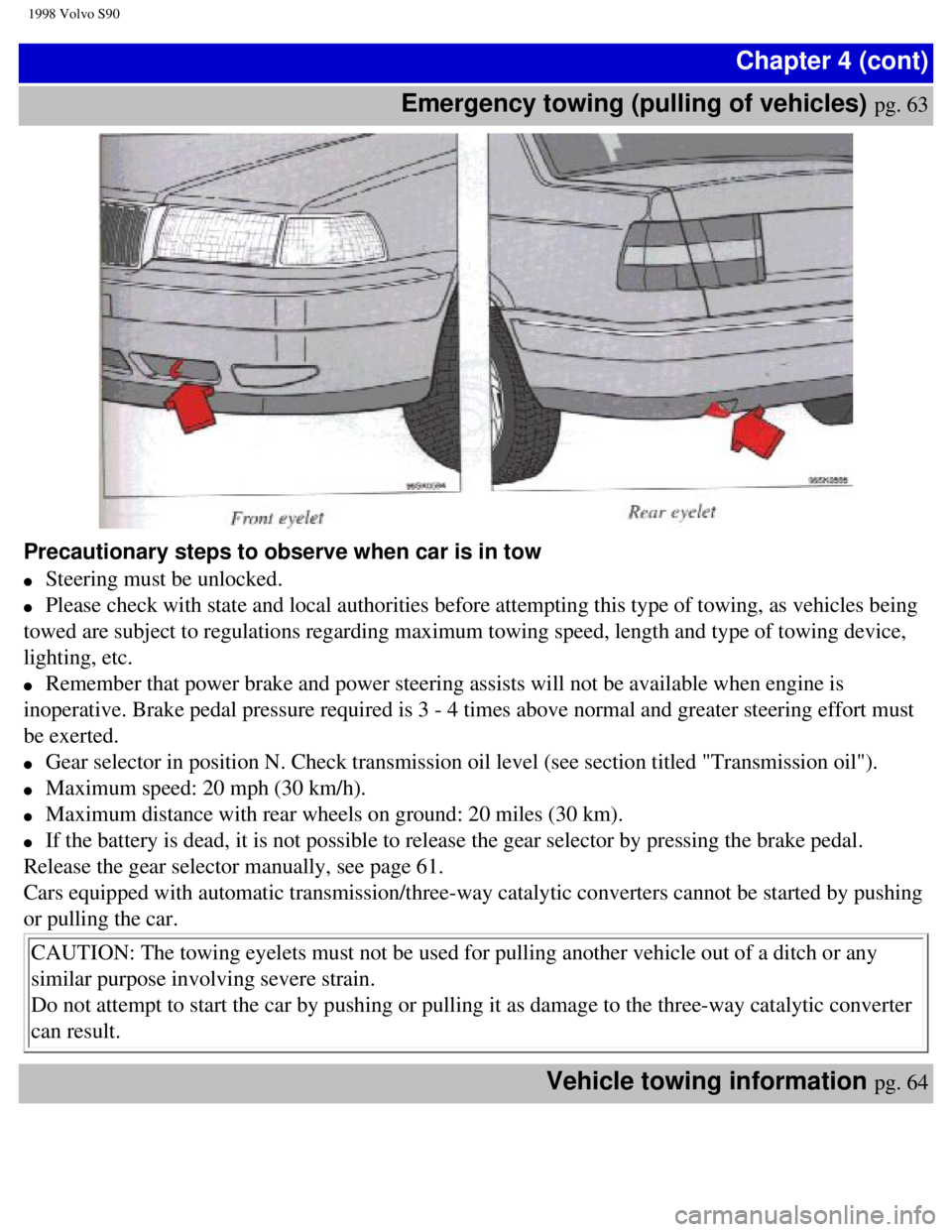
1998 Volvo S90
Chapter 4 (cont)
Emergency towing (pulling of vehicles)
pg. 63
Precautionary steps to observe when car is in tow
l Steering must be unlocked.
l Please check with state and local authorities before attempting this typ\
e of towing, as vehicles being
towed are subject to regulations regarding maximum towing speed, length \
and type of towing device,
lighting, etc.
l Remember that power brake and power steering assists will not be availab\
le when engine is
inoperative. Brake pedal pressure required is 3 - 4 times above normal a\
nd greater steering effort must
be exerted.
l Gear selector in position N. Check transmission oil level (see section \
titled "Transmission oil").
l Maximum speed: 20 mph (30 km/h).
l Maximum distance with rear wheels on ground: 20 miles (30 km).
l If the battery is dead, it is not possible to release the gear selector \
by pressing the brake pedal.
Release the gear selector manually, see page 61.
Cars equipped with automatic transmission/three-way catalytic converters\
cannot be started by pushing
or pulling the car.
CAUTION: The towing eyelets must not be used for pulling another vehicle\
out of a ditch or any
similar purpose involving severe strain.
Do not attempt to start the car by pushing or pulling it as damage to th\
e three-way catalytic converter
can result.
Vehicle towing information pg. 64
file:///K|/ownersdocs/1998/1998_SV90/98S90_063.htm (1 of 4)12/30/2006 \
1:52:43 PM